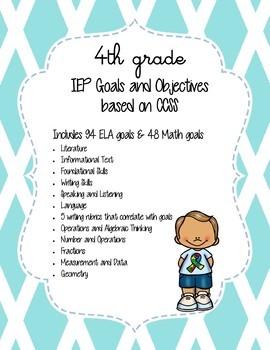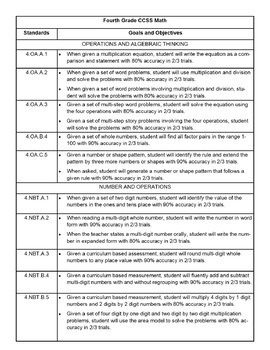IEP Goals and Objectives - 4th Grade
Paige Walters
31 Followers
Resource Type
Standards
CCSS4.MD.A.1
CCSS4.MD.A.2
CCSS4.MD.A.3
CCSS4.MD.B.4
CCSS4.MD.C.5
Formats Included
- Zip
Pages
20 pages
Paige Walters
31 Followers
Description
Make goal writing easy! This is the perfect tool for the development of Individualized Education Plans, aligned with 4th grade Common Core State Standards. All goals are examples and can be edited to fit each individual child. This document includes 94 ELA goals with 5 aligning writing rubrics and 48 Math goals over the following areas:
- Literature
- Informational Texts
- Foundational Skills
- Writing Skills
- Speaking and Listening
- Language
- Operations and Algebraic Thinking
- Number and Operations
- Fractions
- Measurement and Data
- Geometry
**This item has been updated. If you previously downloaded item prior to 4/26/2019, re-download for updated version.
Total Pages
20 pages
Answer Key
Does not apply
Teaching Duration
Lifelong tool
Last updated Mar 1st, 2017
Report this resource to TPT
Reported resources will be reviewed by our team. Report this resource to let us know if this resource violates TPT’s content guidelines.
Standards
to see state-specific standards (only available in the US).
CCSS4.MD.A.1
Know relative sizes of measurement units within one system of units including km, m, cm; kg, g; lb, oz.; l, ml; hr, min, sec. Within a single system of measurement, express measurements in a larger unit in terms of a smaller unit. Record measurement equivalents in a two-column table. For example, know that 1 ft is 12 times as long as 1 in. Express the length of a 4 ft snake as 48 in. Generate a conversion table for feet and inches listing the number pairs (1, 12), (2, 24), (3, 36),...
CCSS4.MD.A.2
Use the four operations to solve word problems involving distances, intervals of time, liquid volumes, masses of objects, and money, including problems involving simple fractions or decimals, and problems that require expressing measurements given in a larger unit in terms of a smaller unit. Represent measurement quantities using diagrams such as number line diagrams that feature a measurement scale.
CCSS4.MD.A.3
Apply the area and perimeter formulas for rectangles in real world and mathematical problems. For example, find the width of a rectangular room given the area of the flooring and the length, by viewing the area formula as a multiplication equation with an unknown factor.
CCSS4.MD.B.4
Make a line plot to display a data set of measurements in fractions of a unit (1/2, 1/4, 1/8). Solve problems involving addition and subtraction of fractions by using information presented in line plots. For example, from a line plot find and interpret the difference in length between the longest and shortest specimens in an insect collection.
CCSS4.MD.C.5
Recognize angles as geometric shapes that are formed wherever two rays share a common endpoint, and understand concepts of angle measurement:



